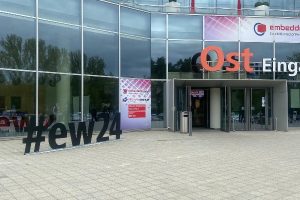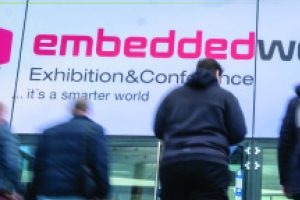 Last year more than 32,200 visitors braved freezing temperatures to come to the exhibition and conference that has become a valued fixture in the embedded industry’s calendar.
Last year more than 32,200 visitors braved freezing temperatures to come to the exhibition and conference that has become a valued fixture in the embedded industry’s calendar.
The Nűrnberg Messe is expected to house more than 1,000 exhibitors showcasing embedded technologies from modules to operating systems, and from embedded software, hardware and software tools to services.
Since 2003 the show has reflected the dynamic embedded industry as it becomes miniaturised, connected and mobile. Themes such as the IoT and e-mobility were identified by many for the first time at the technology fair.
Conference and seminars
Alongside the exhibition there is a conference and seminar programme.
This year Jim Tung – Mathworks fellow – will present the keynote speech on Tuesday 26 February entitled ‘Developing Game-Changing Embedded Intelligence’ and on Wednesday, Jean-Marc Chery – president and CEO of STMicroelectonics – will deliver a keynote presentation entitled ‘Embedded Intelligence for the Next Wave of Smart Systems – Opportunities and Challenges on the Edge’.
The comprehensive conference programme is divided into topics that include the IoT, platforms and applications, connected systems, embedded OS, hardware engineering, software and systems engineering, embedded vision, autonomous and intelligent systems, embedded GUI and HMI and system‑on‑chip. There is also a displays conference that includes seminars about automotive overhead displays and micro-OLEDs, e-signage and new technologies and applications.
Panel discussions
Panel discussions are another regular feature of Embedded World. This year the programme has been re-energised with the addition of topics such as RISC V and embedded intelligence joining established discussion subjects.
‘Safe for the Future’ returns as a subject for a discussion on 27 February. Moderated by professor Peter Fromm from the University of Darmstadt, the panel will cover the safety and security of embedded systems and the protection of computers and communication channels.
This year, the key topic is the protection of networked embedded systems in the IoT and the effective combining of data protection and functional security (safety).
Members of the panel are:
- Professor Peter Liggesmeyer, scientific director of the Fraunhofer Institute for Experimental Software Development (IESE) in Kaiserslautern
- Thomas Pilz, managing partner of safety specialist Pilz in Ostfildern
- Nigel Stanley, CTO for operational technology and industrial cyber security CoE at TÜV Rheinland.
The panel discussions will take place in the exhibitor forums.
On Thursday 28 February, in Forum Hall 3A, the VDMA’s (Germany’s mechanical engineering industry association) machine vision group will discuss the migration of vision systems from PC-based to embedded systems and the potential for intelligent image processing systems as well as future applications and challenges.
Autonomous driving is an application that relies on camera-based security systems, although use cases are emerging in the factory, retail, consumer and medical sectors.
The panel discussing the future of machine vision will include:
- Jeff Bier, founder of the Embedded Vision Alliance and president of BDTI
- Olaf Munkelt, managing director of MVTec Software
- Amir Sherman, director of engineering solutions and embedded technology EMEA for Arrow Central Europe
- Markus Tremmel, driver assistance systems chief expert at Robert Bosch
- Leon Farasati, director of product management for Snapdragon Embedded at Qualcomm Technologies.
Young talent
On Thursday 28 February, Student Day runs from 9am to 5.30pm in Hall Brüssel at the exhibition centre.
Students from universities in Austria, the Czech Republic, France, Germany, Italy and Poland will attend and listen to a keynote presentation by Ralf G Herrtwich from the Technical University Berlin. The talk is entitled ‘Maps as Collective Brains for Vehicle Automation’. It will be followed by a short panel discussion with representatives from Arrow, the Bluetooth SIG, Cypress Semiconductor, Digi-Key, dspace, Phytec and Renesas.
There will also be an area dedicated to start-up companies located in one of the newer halls, 3A. Here, young companies will have a dedicated space to present their ideas to the embedded community.
Servers get really small
Congatec is presenting tiny servers at Embedded World (stand 1–358). It has squeezed an Intel Core i7‑8565U (Whiskey Lake) on to a 146x102mm board (nominally 3.5‑inch).
“Compared to similar processors of the Kaby Lake U generation, the soldered Intel Core i7 processor of the eighth generation Whiskey Lake family offers quad core instead of dual core support at the same power consumption and therefore up to 40% more multi‑thread performance,” said the company.
“Commercial variants with the same power consumption also provide Intel Optane memory support for ultra-fast responsiveness,” it said.
USB 3.1 Gen 2 is supported at 10Gbit/s and there is an integrated USB-C connector with both power delivery and graphics transmission.
Clock rates extend to 4.6GHz and power is 15W, so “these boards can achieve a performance that about four years ago was only found in actively cooled monster laptops consuming 60W or more”, said Congatec.
Conga-B7E3 , a second small server is on a 125x95mm COM Express Type 7 module fitted with an AMD EPYC Embedded 3000 processor, operating at up to 100W. “The modules bring true server-class performance to an embedded module form factor, which currently supports up to 96Gbyte of on-board memory with 4x 10Gb Ethernet and up to 32 PCIe lanes. It can connect with up to four MXM-based GPGPU cards for artificial intelligence systems.
“Expectations for even more server‑on‑module performance in the future have already been set,” said the company. “The COM-HD working group of the PICMG shared initial information at SPS/IPC/Drives 2018 on a new COM Express module standard, which will be designed for even faster high-speed interfaces, such as 30Gb Ethernet, PCIe Gen 4 and 5, and which will also provide significantly more interfaces.”
Part of the Congatec stand will be set aside for vision and AI projects, including an Arm i.MX8 based SMARC 2.0 module will drive Basler MIPI CSI-2 cameras via a Connect Tech baseboard.
“With such projects, Congatec hopes to grow in the field of industrial vision, and to be a key driver in autonomous robotic vehicles,” said the company.
Automotive, power and education top Tektronix’ list
Tektronix is to feature four areas (stand 4–160), which will cover embedded design, power electronics, automotive, and education and research.
Publicly showing for the first time will be 1mV-accurate power rail probes: TPR1000 and TPR4000. Designed specifically for minimising noise, they work with up to 60V of offset.
There will also be the company’s recently announced ‘6’ series of mixed signal oscilloscopes, built around an in-house-designed asic and work up to 8GHz and 25Gsample/s simultaneously on four channels.
The earlier ‘5’ series gets new automotive-specific software tools designed to speed up validation and debug and for electronics systems found in vehicles.
Visitors will also see an arbitrary waveform and function generator called AFG31000 that is said to have the largest touch screen for its kind, the DMM6500 6½-digit multimeter and the DAQ6510 data acquisition and logging multimeter.
Heitec expands its sub-rack portfolio
Heitec will present sub-rack elements (stand 1–340), based on new architectures and designed primarily for serial backplane technology, high speed and the simple design of modular platforms. The company is aiming its products at demanding applications and challenging environments.
Its 1U HeiCool ECO fan tray is compatible with the entire HeiCool line and can be inserted into a 19‑inch cabinet using standard fixings, for retro‑fit into previously fanless applications, for example, or it can be built in.
Accessories for the HeiCase line for 19‑inch enclosures now include shelves, front panels and cable management as well as a document tray.
Among demonstrations will be systems developed for customer specifications, including a highly-available carrier‑grade network node for high‑speed optical networks. The company used AdvancedTCA‑based housing with intelligent redundant cooling and hot swappable power supplies “special emphasis was put on long-term availability, product stability and ease of maintenance”.
For a spectrophotometer manufacturer, Heitec took over the design and supply chain management of the electronic control unit carrier board and supported the selection of the modules, production, testing and documentation. “The challenge was to accommodate electronics in the limited space of the tailored carrier board,” said the company.
Debug engine adds hypervisor awareness for Cortex-A53
German company Programmierbare Logik & Systeme (PLS) is to reveal version 5.0 of its Universal Debug Engine (UDE) (stand 4–310).
A new feature is that it can develop virtualised applications for Arm Cortex-A53, by providing hypervisor awareness for Lynx Software Technologies’ LynxSecure hypervisor.
“At present there is a trend to consolidate multiple applications, which in the past used separate hardware, on a single computing platform,” said PLS. “However, different requirements in terms of safety, security and real-time behaviour demand strict isolation, which can only be achieved by virtualisation. With the hypervisor awareness, the developer can now use the debug capabilities of the UDE for the development of virtualised applications too.”
Specific features of the Arm Cortex-A53, such as two-stage address translation or the support of virtual interrupts, are handled transparently for the user.
Such hypervisor awareness enables the user to debug a bare-metal application as usual and as if it was running on real hardware instead of being encapsulated in a virtual machine.
If required, UDE also provides support for debugging and system analysis of the hypervisor itself.
For each individual virtual machine, both the state and the contexts can be displayed. In addition, information about the memory layout of the individual virtual machines, as well as the mapping of the virtual memory addresses to physical memory addresses, is provided.
Handling of large quantities of recorded trace data has been improved in V5.0. For example, time-accurate display of executed functions and operating system tasks can now be sorted and filtered according to different criteria – and it links allow navigation from the recorded functions to the source code.
“In combination with the add-in for the support of real-time operating systems according to the OSEK standard [open systems and their interfaces for the electronics in motor vehicles] the operating system tasks and associated runnables can be clearly displayed and measured,” claimed PLS.
New processors covered include the 32-bit Arm Cortex-R52 and the NETX 90 Cortex-M microcontroller.
Adesto promotes LonWorks over internet protocol
Adesto, the new owner of Echelon, will be promoting LonWorks and its ecosystem (stand 4A–124).
In particular the company will focus on recently-approved ANSI/CTA 709.7 – Lon IP protocol that enables native Lon communication over any IP (internet protocol) transport such as Ethernet and Wi-Fi, as well as offering interoperability with IP-based web services.
With this, building and industrial automation based on LonWorks can “seamlessly and securely interoperate with cloud and IoT applications”, according to Adesto.
Lon IP describes the set of requirements for users, developers, vendors, integrators and specifiers of open building and industrial control systems to develop Lon devices with native IP transport – the latter can boost communication bandwidth and increase communication flexibility.
Adesto will provide multi‑protocol transceiver chipsets that support Lon, Lon IP and other IP-based protocols such as BACnet IP, as well as Open MQTT‑based web services protocol (IAP) and APIs that can connect to Lon and other control protocols.
The chipsets will also support edge servers and network interfaces that provide connectivity from IP cloud services to protocols including Lon, Modbus, and BACnet.
Antenna for wireless lighting
UK-based antenna maker Antenova has created a product for wireless lighting that can be used on metal surfaces (stand 3–331).
Magna (part SR4I051) is aimed at industrial IoT and smart buildings and operates in the ISM 868/915MHz bands.
It uses two electrical layers, isolated from one another, which enables an antenna to radiate on a metal surface or housing – an environment where it is usually difficult for an antenna to operate, said the company.
Magna is part of the company’s Reflector family, and another member, 1,559-1,609MHz Robusta, won the Hardware Award at last year’s Embedded World. Magna comes with a cable and an IPEX connector, and has an adhesive underside to fix it.
The company will also show a blade antenna for LTE Cat M1. Its latest reference design for a small OBDII (on board device, pictured) – LTE Cat M1 – is an IoT-friendly version of LTE that provides enough bandwidth for data communication while maintaining a long battery life.
The blade antenna (part SR4G055) is 41x22x0.9mm and the OBDII unit operates in the 4G/LTE frequencies 698‑894MHz and 1,710-2,155MHz.
Customers can design their own circuitry into the unit “and be confident of gaining LTE CatM1 certification”, said Antenova. Bluetooth and GNSS antennas can be added and will coexist on-board.
Example applications are trackers, portable devices, drones, network devices, smart metering, dashboard equipment and telematics.
Arrow show cases AI
Arrow Electronics will show potential users how to harness the power of artificial intelligence (AI) in their applications (stand 4A–340). It has teamed up with suppliers to offer technology, guidance and support across sectors including industrial, healthcare and transport.
“The ability to deploy AI within edge computing is unlocking a range of possibilities,” said the distributor. “Machine vision, well established in the industrial sphere, can be taken to the next level with AI enabling identification of objects and people. This can also expand the role of robotic systems in terms of their ability to recognise, analyse, make decisions, and safely work alongside human operators instead of in a caged area,” the company said.
Where to find us
Embedded World 2019 takes place 26-28 February in Nuremburg.
Visit Electronics Weekly at Hall 3A-700.
 Electronics Weekly Electronics Design & Components Tech News
Electronics Weekly Electronics Design & Components Tech News



